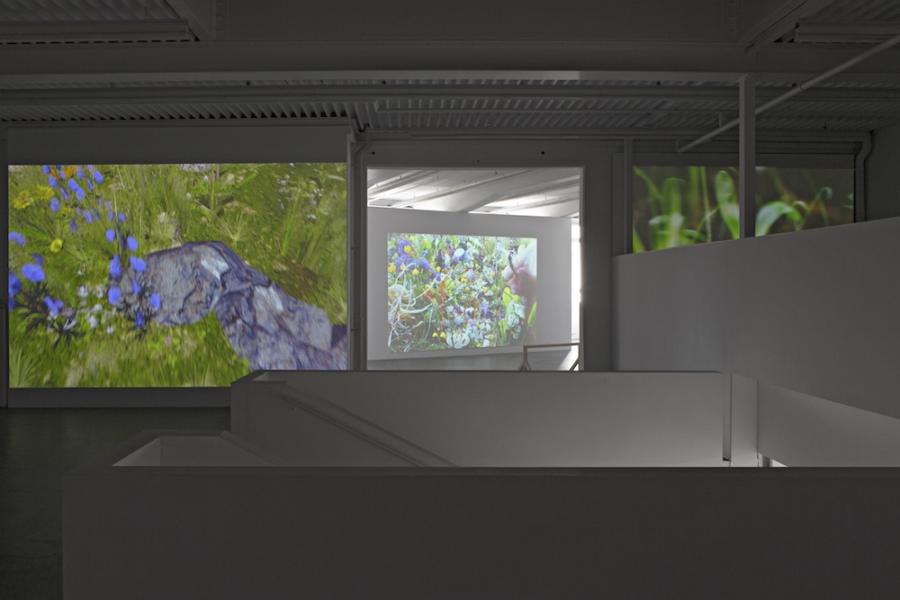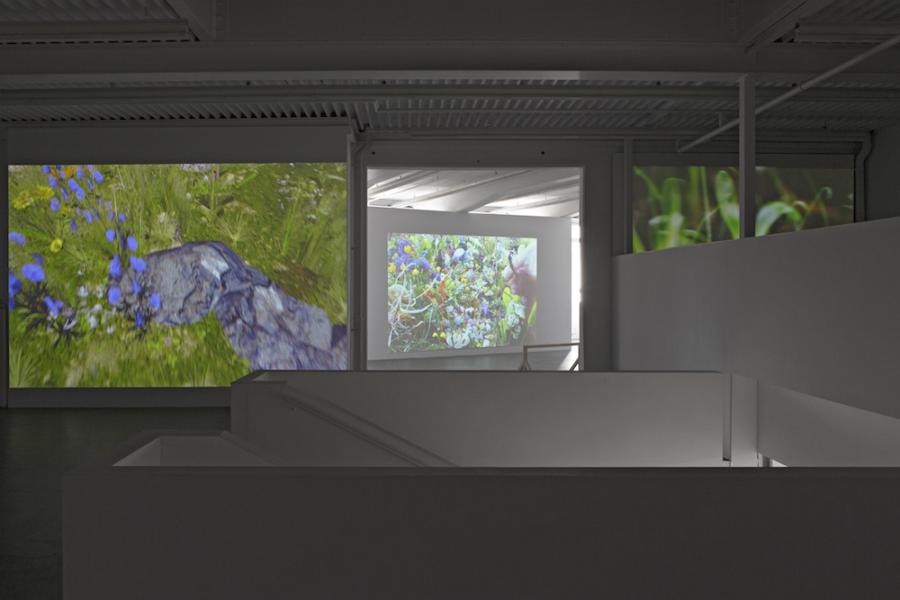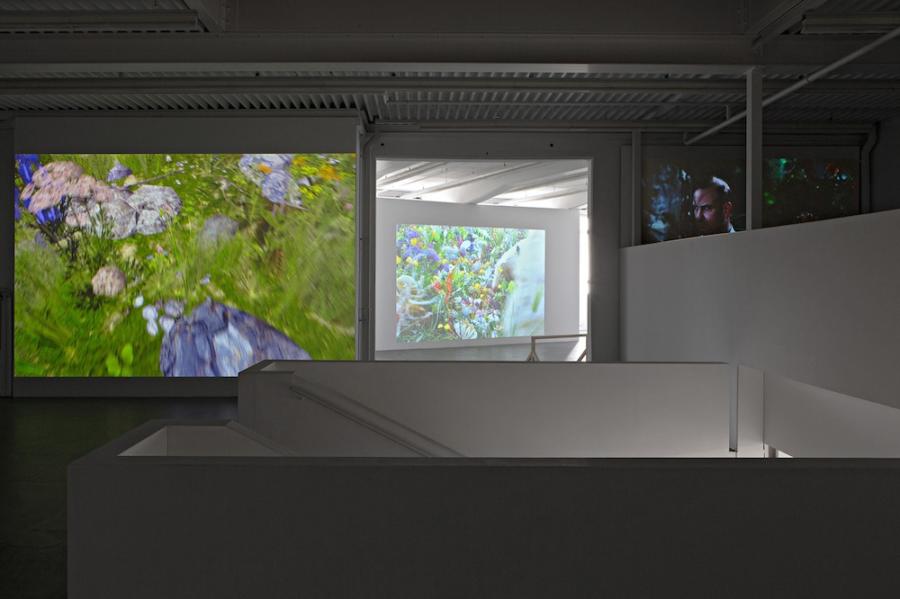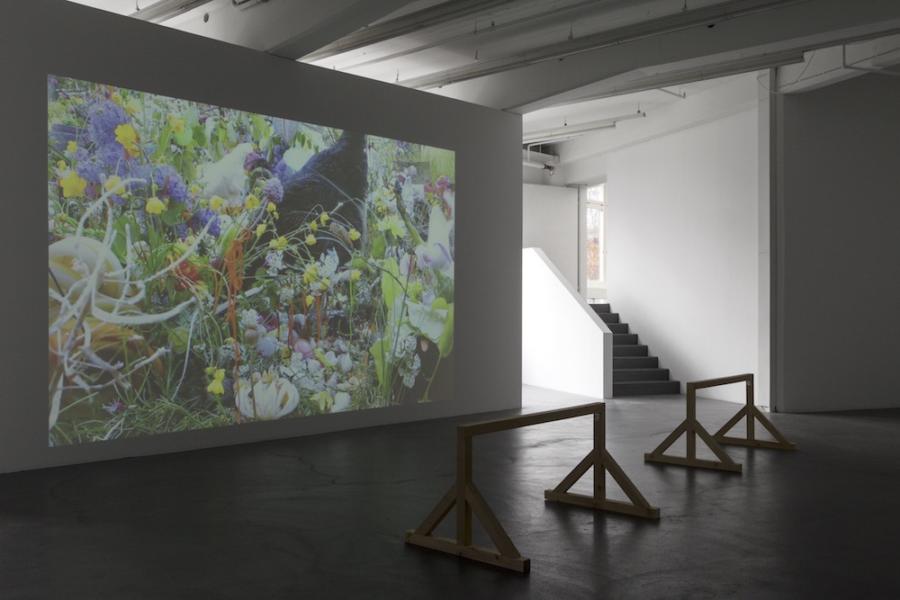Sehnsuchtsorte / Places of Longing
What could our places of longing be? What identifies them and what might endanger them? What accords with our personal image of an extraordinary day, an unusual experience of nature or a paradisiac state, for us or other beings? Can we find this amid the quotidian? In the most varied manner selected video works investigate this question of the societal and individual longing for an ideal place of being oneself. With works by Teresa Hubbard / Alexander Birchler, Max Philipp Schmid, Gerda Steiner & Jörg Lenzlinger and Monica Studer / Christoph van den Berg.
The video work Eight by Teresa Hubbard / Alexander Birchler already references in its title both what is to be told here as well as the structure of its narrative. It apparently revolves around the (eighth) birthday of a girl — and this in an endless loop. The camera is in a continuous dolly movement, only interrupted by two short editing sequences, from the interior of a house to the outside yard and back. The localization of and transition between interior and exterior here remain just as unresolved as do the starting and termination points of the narrative. The girl is oscillating back and forth through these ambiguous states. Having arrived in the rainy, nocturnal yard, she approaches the remnants of the drenched party and cuts herself a piece of the birthday cake. Yet before she can take a bite, the girl has already arrived back in the house, only to recommence her journey back outside. At the point where the bounds between inside and outside — sheltered home and stormy world — are traversed by the girl, the spatial order has already been reversed. Eight marks a passage of the girl leaving the ‘shelter’ of childhood and becoming an adolescent. Eight was shot on location in Austin, Texas in 2001.
A decade after creating Eight, Hubbard / Birchler began searching for the child actor, whom they had cast for the role of the girl in Eight. Locating her in Boston, the child actor has grown up to become a contemporary dancer. Eighteen picks up on the same character in a scene of her eighteenth birthday party. As in the work Eight, Hubbard / Birchler have developed a narrative perspective that is unsettled, does not come to closure and oscillates between adolescence and adulthood. As the protagonist journeys from one place to another, linear time, fact and fiction, and the solidity of physical shelter constantly slip around her. Steady, uninterrupted camera movements straddle constructed and actual locations, inside and outside, rain and sunshine, day and night, summer and winter. Eighteen incorporates three musical compositions, arranged and performed on guitar: the Gymnopédies by Erik Satie. Written for piano in 1888, these movements share a common structure and collectively are regarded as an important precursor to modern ambient music. Eighteen was shot on location in Austin, Texas in 2012.
The videos Eight and Eighteen by Teresa Hubbard / Alexander Birchler will be screened at different times. Eighteen: 25 January—16 March 2018; Eight: 17 March—2 April 2018.
We are familiar with this gaze — travelling over an Alpine flower meadow that bursts with spring, a meadow with grasses, different plants and stones. The gaze glides endlessly about, indulgently pursuing what it notices — on and on, with the expectation that this gaze will, soon, be lifted in order to see the horizon, the breadth of the landscape or an urban context. But this wish is never satisfied in Monica Studer / Christoph van den Berg’s work Wiese (Meadow). There is no swift survey of what has been seen, nor is there a final overview of the landscape which has just been travelled visually. So, almost longingly, the eye follows the real-time animation which Studer / van den Berg made using digital 3D computer game technology. The images are continually rendered afresh in real time. Flowers, grasses, stones and branches emerge repeatedly anew as 3D objects and lead us into infinite digital tracking shots through the fictitious landscape. Yes, you can lean back and enjoy this animation of time and movement, and be delighted by flora and fauna. Yet much as we are fascinated by how closely linked fiction and our perception of reality are, and how nature can also be enjoyed as a digital animation, a feeling of insecurity and discomfort is mixed in too. The gaze can never be raised from the ground to find out where this meadow leads.
P-A-R-A-D-I-E-S (PARADISE) spells out the protagonist in Max Philipp Schmid’s video work. Slowly, almost clumsily. Sitting in the middle of a greenhouse, the question quickly surfaces: what vision do we have of paradise or a paradisiac state? Is a little bit of nature tamed inside a greenhouse enough? And what about the everyday idylls we often try to arrange, with our perfectly designed and fenced front gardens, city greening or strange urban furnishings that sometimes have bizarre effects, but which do not nonetheless hide the facts of hard urban reality? The “hortus conclusus”, the enclosed and thus protected small garden seems to be evoked perennially, up and down the land, as an idealised refuge. In his video work Max Philipp Schmid carefully observes the everyday in order to enquire humorously and insightfully about how closely the general trend towards retreat and compartmentalisation is tied to an ideal of life in harmony with nature.
“Sie sind ja auch nur spirituelle Wesen, die Erfahrungen eines Lebens als Huhn machen…“ Gerda Steiner & Jörg Lenzlinger in conversation with Ines Goldbach (only in German, please switch to the German version).
The exhibition was generously supported by the partners of the Kunsthau Baselland: kulturelles.bl, Migros Kulturprozent, Gemeinde Muttenz, Anthony Vischer, prolog.work, werner sutter AG, burckhardt partner.
Curator: Ines Goldbach
For more information please visit Kunstverein Baselland.




